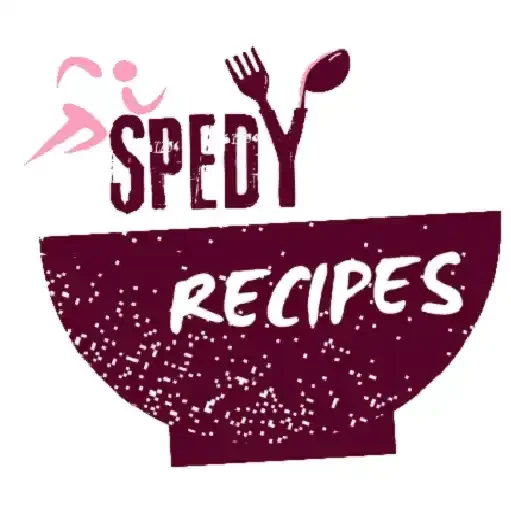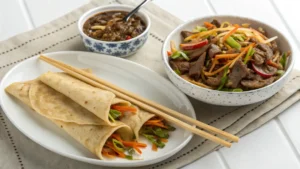The Ultimate Guide to Moo Shu Beef: History, Recipes, and Expert Tips
Have you ever encountered a dish that’s both fun to eat and packed with flavor? Well, let me introduce you to Moo Shu Beef! It’s a Chinese-American classic that involves tender beef, colorful veggies, and a sweet and savory sauce, all wrapped up in thin pancakes. Sounds delicious, right? Let’s dive into the world of Moo Shu Beef and discover its secrets. 😋
Table of Contents
What is Moo Shu Beef? A Culinary Journey
Moo Shu Beef isn’t just a meal; it’s an experience. Imagine biting into a soft pancake filled with perfectly cooked beef, crunchy vegetables, and a rich, flavorful sauce. It’s a symphony of textures and tastes that dance on your tongue. But where did this delightful dish come from?
Origins and History of Moo Shu Cuisine
The story of Moo Shu starts in Northern China, specifically in the Shandong province. The original dish, Moo Shu Pork (木须肉), which translates to “wood ear meat,” featured pork, wood ear mushrooms (which resemble tree bark), and scrambled eggs. It was a simple, home-style dish that showcased the region’s culinary traditions. Think of it as a Chinese comfort food, like mac and cheese is for many Americans. 🍜
The Evolution of Moo Shu Beef in America
Like many dishes that travel across the globe, Moo Shu underwent some changes when it arrived in America. Chinese immigrants brought their culinary heritage with them, adapting their recipes to suit local tastes and available ingredients. 1 Beef became a popular substitute for pork, and other vegetables like cabbage, carrots, and scallions were added to create a more vibrant and colorful dish. This Americanized version became known as Moo Shu Beef, and it quickly gained popularity in Chinese-American restaurants across the country. It’s a testament to how food can evolve and adapt, becoming a delicious fusion of cultures.
Key Ingredients for Authentic Moo Shu Beef
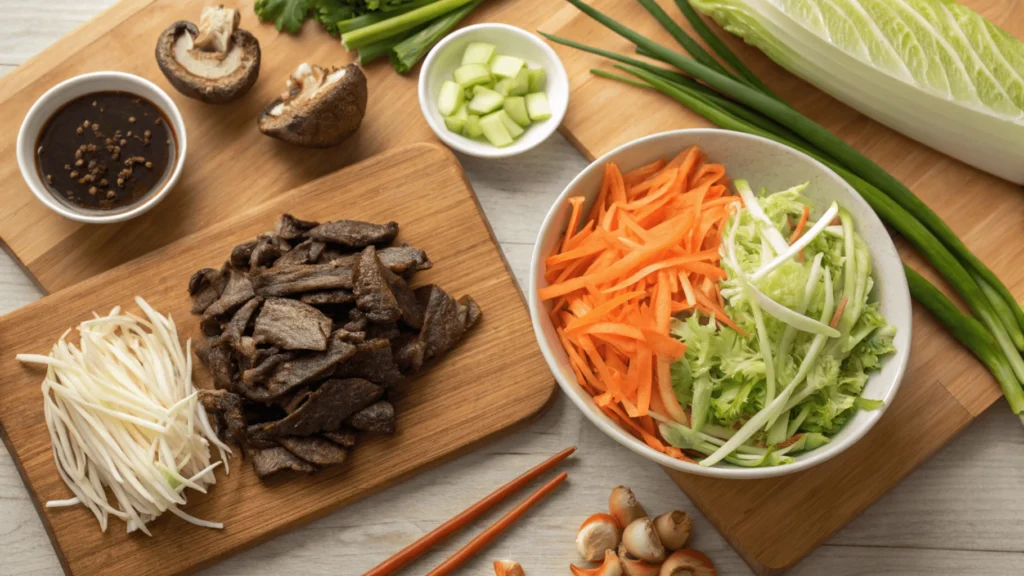
To make truly delicious Moo Shu Beef, you need the right ingredients. It’s like building a house – you need solid foundations to create something amazing. Here are the key players in this culinary masterpiece:
The Essential: Tender Sliced Beef
The star of the show is, of course, the beef. Thinly sliced beef, usually flank steak or sirloin, is the preferred choice. The thin slices ensure that the beef cooks quickly and remains tender. Imagine trying to bite into a thick steak in a small pancake – not ideal, right? Thin slices are key!
Moo Shu Vegetables: A Colorful Medley
Moo Shu isn’t just about the beef; the vegetables play a crucial role in creating the dish’s unique texture and flavor. Common vegetables include:
- Shredded Cabbage: Adds a nice crunch.
- Carrots: Provide sweetness and color.
- Scallions: Offer a mild onion flavor.
- Wood Ear Mushrooms (Optional): Give an earthy, slightly chewy texture.
- Bamboo Shoots (Optional): Add a subtle sweetness and crispness.
This mix of vegetables creates a beautiful rainbow of colors and a delightful mix of textures, from crunchy to slightly soft. 🥕🥬
The Magic of Hoisin Sauce: Sweet and Savory
Hoisin sauce is the secret weapon that gives Moo Shu Beef its signature sweet and savory flavor. It’s a thick, dark sauce made from fermented soybeans, sugar, spices, and garlic. Think of it as the “glue” that holds all the flavors together, creating a harmonious and delicious experience.
Thin Pancakes: The Perfect Wrap
No Moo Shu Beef is complete without the thin pancakes, also known as Mandarin pancakes or moo shu wrappers. These delicate pancakes are similar to crepes and are used to wrap the beef and vegetable mixture. They add a soft, slightly chewy texture that complements the other ingredients perfectly. They’re like the edible plates that hold the whole delicious package together! 🥞
Mastering the Art of Cooking Moo Shu Beef: A Step-by-Step Guide
Now that we know the key ingredients, let’s talk about how to cook Moo Shu Beef like a pro. Don’t worry, it’s not as complicated as it might seem.
Preparing the Beef: Marinating for Maximum Flavor
Marinating the beef is essential for tenderizing the meat and infusing it with flavor. A simple marinade of soy sauce, rice wine (or dry sherry), and cornstarch is a great starting point. The cornstarch helps to create a protective coating around the beef, keeping it juicy during cooking. Imagine marinating as giving the beef a flavor bath, making it extra delicious! 🛁
Stir-Frying Techniques: Achieving Perfect Texture
Stir-frying is the cooking method of choice for Moo Shu Beef. It involves cooking the ingredients quickly over high heat in a wok or large skillet. This technique ensures that the beef is cooked through but remains tender, and the vegetables retain their crispness. It’s like a quick dance in a hot pan! 🔥
Assembling the Moo Shu: The Art of the Wrap
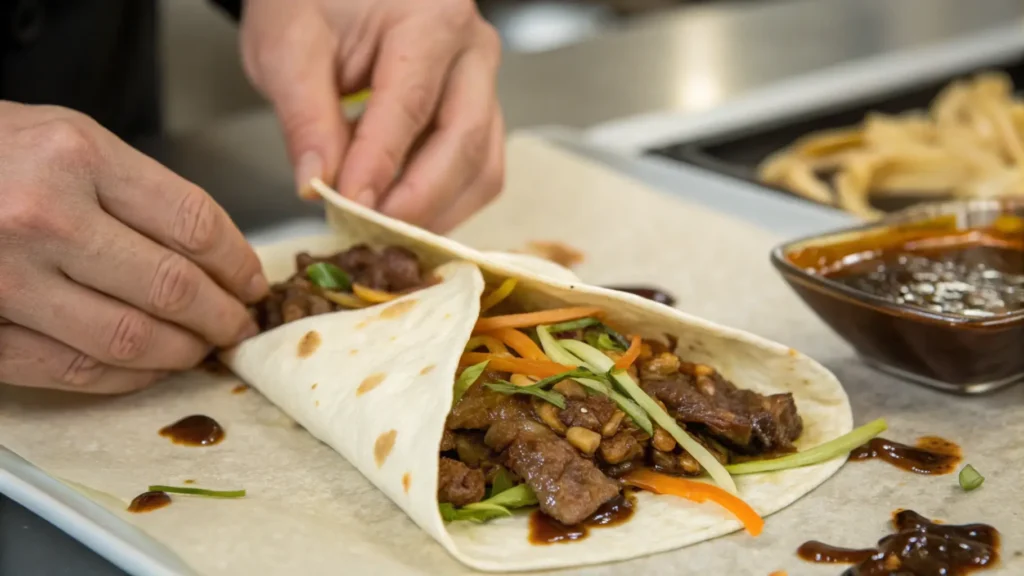
The final step is assembling the Moo Shu. Spread a thin layer of hoisin sauce on a pancake, then add a spoonful of the beef and vegetable mixture. Fold the sides of the pancake inwards, then roll it up like a burrito. And there you have it – a delicious Moo Shu Beef wrap, ready to be devoured! 🌯
Here’s a quote from a culinary expert on the importance of fresh ingredients:
“The quality of your ingredients directly impacts the flavor of your dish. Using fresh, high-quality ingredients is the key to creating truly exceptional food.”
This is especially true for Moo Shu Beef. Fresh vegetables and good quality beef will make a world of difference.
Nutrition Facts (per serving, approximate)
| Nutrient | Amount |
|---|---|
| Calories | 300-400 |
| Protein | 20-25g |
| Fat | 15-20g |
| Carbohydrates | 30-40g |
Example Ingredients and Quantities:
| Ingredient | Quantity |
|---|---|
| Flank Steak | 1 lb |
| Cabbage (shredded) | 2 cups |
| Carrots (shredded) | 1 cup |
| Scallions (chopped) | 1/2 cup |
| Hoisin Sauce | 1/4 cup |
| Moo Shu Pancakes | 8-10 |
Common Moo Shu Beef Problems and Solutions
Have you ever made Moo Shu Beef and encountered some common problems? Maybe your beef came out dry or tough, or your pancakes were soggy, or the flavor was a bit bland? Don’t worry, you’re not alone! These are common problems that even experienced cooks can face. But don’t let them discourage you, because there are easy solutions to get you back on track.
We’re here to help you troubleshoot some of the most common Moo Shu Beef problems and provide solutions so you can create a delicious and satisfying dish every time.
Problem: Dry or Tough Beef
Solution: The key to tender and juicy beef is proper marinating and cooking time. Make sure to marinate the beef for at least 30 minutes, or even overnight, in a flavorful marinade. When it comes to cooking, stir-fry the beef quickly over high heat until it is just cooked through. This will help to lock in the moisture and prevent it from becoming dry or tough.
Problem: Soggy Pancakes
Solution: Soggy pancakes are a common problem when making Moo Shu Beef. To avoid this, make sure to cook the pancakes in a lightly greased skillet over medium heat until they are golden brown and slightly crispy. Once cooked, place them on a paper towel-lined plate to absorb any excess oil. You can also reheat leftover pancakes in a dry skillet over low heat to crisp them up again.
Problem: Bland Flavor
Solution: If your Moo Shu Beef is lacking flavor, don’t worry! There are a few things you can do to boost it. First, make sure you’re using a good quality hoisin sauce. Hoisin sauce is the foundation of the dish, so a good-quality one will make a big difference. You can also add a touch of other seasonings, such as ginger, garlic, or sesame oil, to enhance the flavor. Finally, don’t be afraid to adjust the amount of hoisin sauce to taste.
Problem: Vegetables Too Mushy
Solution: Vegetables should be crisp-tender in Moo Shu Beef. To achieve this, add them to the pan after the beef is cooked. This way, they will have a chance to cook quickly without becoming mushy. You can also blanch the vegetables briefly in boiling water before stir-frying them to help them retain their crispness.
Problem: Not Enough Sauce
Solution: If you find that your Moo Shu Beef is a bit dry, you can easily add more sauce. Simply make a double batch of the hoisin sauce or use a bottled hoisin sauce. You can also add some additional stir-fry sauce or even a splash of chicken broth to loosen things up.
Problem: Not Enough Pancakes
Solution: If you find that you don’t have enough pancakes to wrap up all of your Moo Shu Beef, you can easily make more. Simply follow the recipe for the pancakes, using whatever flour you have on hand. You can also use store-bought tortillas or egg rolls if you’re in a pinch.
Problem: Leftover Moo Shu Beef
Solution: Moo Shu Beef is a great leftover dish. You can simply reheat it in the microwave or on the stovetop. If the pancakes are a bit dry, you can add a little bit of water or oil to the pan to help them stay moist. You can also use leftover Moo Shu Beef to make a delicious stir-fry or noodle dish.
By following these tips, you can avoid common problems and create delicious Moo Shu Beef every time. Remember, the key to a great dish is to use fresh ingredients, marinate the beef properly, and cook everything over high heat. With a little practice, you’ll be a Moo Shu Beef master in no time!
Additional Tips:
- If you don’t have a wok, you can use a large skillet or frying pan.
- Be sure to have all of your ingredients prepped and ready to go before you start cooking.
- Don’t overcrowd the pan when stir-frying the beef and vegetables. Work in batches if necessary.
- If you’re making Moo Shu Beef for a large group, you can double or triple the recipe.
Serving Suggestions
Moo Shu Beef is traditionally served with thin pancakes, but you can also serve it with rice or noodles. It’s a great dish for a weeknight meal or a special occasion.
I hope these tips help you create delicious and satisfying Moo Shu Beef. If you have any other questions, please feel free to leave a comment below.
Here’s a quote from a famous chef on the importance of practice:
“The more you cook, the better you will become. Don’t be afraid to experiment and try new things. The only way to improve is to practice, practice, practice.”
So don’t be discouraged if you don’t get it right the first time. Keep practicing, and you’ll be rewarded with a delicious and satisfying meal.
Variations and Modern Twists on Moo Shu Beef
While the classic Moo Shu Beef is undeniably delicious, there’s always room for experimentation and creativity in the kitchen. Here are a few variations and modern twists you can try:
Vegetarian Moo Shu: Tofu and Mushroom Options
If you’re vegetarian or simply looking for a meatless option, you can easily adapt Moo Shu Beef by substituting the beef with tofu or mushrooms.
- Tofu: Use firm or extra-firm tofu, press it to remove excess water, and then cube or crumble it. You can marinate the tofu similarly to how you would marinate the beef, using soy sauce, ginger, and garlic. Tofu absorbs flavors well, so it’s a great substitute.
- Mushrooms: Shiitake, wood ear, or cremini mushrooms are excellent choices for a vegetarian Moo Shu. They provide a meaty texture and an earthy flavor that complements the other ingredients.
Spicy Moo Shu: Adding a Kick of Heat
For those who like a bit of heat, you can easily add some spice to your Moo Shu Beef. Here are a few ways to do it:
- Add chili flakes or chili oil to the stir-fry.
- Include a dash of Sriracha or other hot sauce in the hoisin sauce.
- Use fresh chili peppers, such as jalapeños or serranos, in the vegetable mixture.
Start with a small amount of spice and adjust to your liking. Remember, you can always add more, but you can’t take it away! 🔥
Moo Shu Chicken and Pork: Exploring Different Proteins
While beef is the most popular choice in America, you can also make Moo Shu with other proteins:
- Chicken: Use thinly sliced chicken breast or thigh meat. Marinate it similarly to the beef. Chicken cooks quickly, so be careful not to overcook it.
- Pork: As we discussed earlier, the original Moo Shu was made with pork. Use thinly sliced pork tenderloin or shoulder.
Exploring different proteins can add variety to your Moo Shu experience.
Serving and Enjoying Moo Shu Beef: A Complete Experience
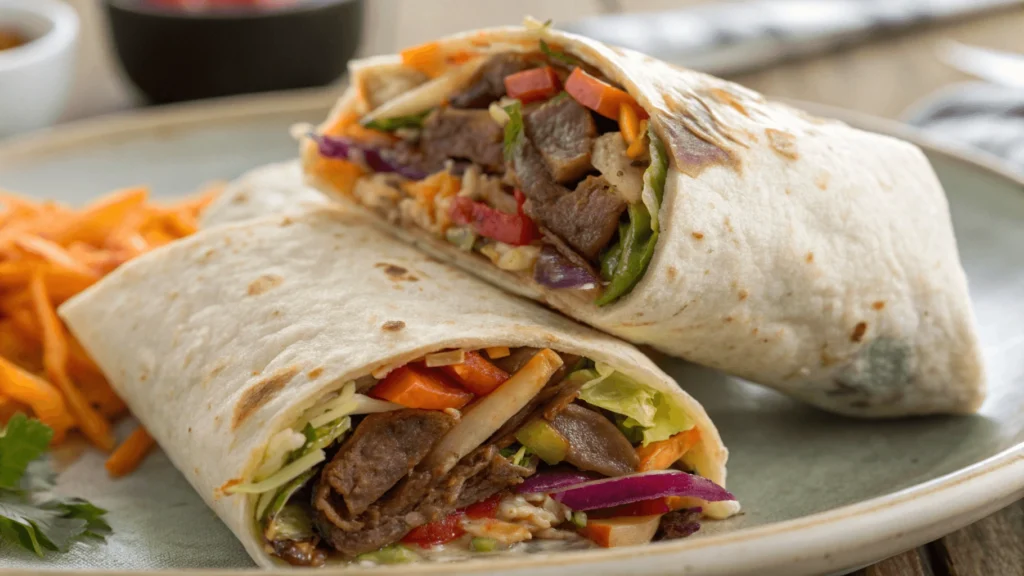
Moo Shu Beef is a versatile dish that can be enjoyed in various ways.
Traditional Accompaniments: Rice, Noodles, and More
While the thin pancakes are the traditional accompaniment, you can also serve Moo Shu Beef with:
- Steamed rice: A classic and simple option.
- Noodles: Lo mein or rice noodles work well.
- Lettuce wraps: For a lighter, lower-carb option.
The Perfect Presentation: Plating and Garnishing
Presentation matters! Here are a few tips for making your Moo Shu Beef look as good as it tastes:
- Arrange the pancakes neatly on a plate.
- Serve the beef and vegetable mixture in a separate bowl.
- Provide a small bowl of hoisin sauce for dipping.
- Garnish with chopped scallions or sesame seeds.
Moo Shu Beef: Frequently Asked Questions (FAQ)
Here are some frequently asked questions about Moo Shu Beef:
Can I make Moo Shu Beef ahead of time?
Yes, you can prepare the beef and vegetable mixture ahead of time and store it in the refrigerator. Reheat it before serving. However, it’s best to cook the pancakes fresh or reheat them just before serving to prevent them from becoming soggy.
How do I reheat Moo Shu Pancakes?
You can reheat the pancakes in a dry skillet over low heat or in the microwave for a short time. Be careful not to overheat them, as they can become dry and brittle.
Where can I buy authentic Moo Shu Pancakes?
You can find Moo Shu Pancakes in most Asian grocery stores or some well-stocked supermarkets. You can also make them at home if you’re feeling adventurous.
What is the difference between Moo Shu Pork and Moo Shu Beef?
The main difference is the protein used. Moo Shu Pork uses pork, while Moo Shu Beef uses beef. The other ingredients and cooking methods are generally the same.
Moo Shu Beef
Equipment
- Wok or Large Skillet
- Mixing Bowls
- Knife
Ingredients
Beef Marinade
- 1 lb flank steak thinly sliced
- 2 tbsp soy sauce
- 1 tbsp rice wine or dry sherry
- 1 tsp cornstarch
Vegetables
- 2 cups shredded cabbage
- 1 cup shredded carrots
- 1/2 cup chopped scallions
Sauce & Wrappers
- 1/4 cup hoisin sauce
- 8 Moo Shu pancakes or thin crepes
Instructions
- In a bowl, mix the beef slices with soy sauce, rice wine, and cornstarch. Let it marinate for at least 20 minutes.
- Heat a wok or skillet over high heat. Stir-fry the beef for 2-3 minutes until browned. Remove and set aside.
- In the same pan, add cabbage, carrots, and scallions. Stir-fry for 3 minutes until slightly softened.
- Return the beef to the pan and stir in hoisin sauce. Cook for 1 more minute.
- Spread a thin layer of hoisin sauce on each pancake, add the beef mixture, and roll it up.
Notes
The Enduring Appeal of Moo Shu Beef: A Timeless Classic
Moo Shu Beef has remained a popular dish for decades because it offers a delightful combination of flavors, textures, and versatility. It’s a dish that can be enjoyed by people of all ages and culinary backgrounds. Whether you’re a seasoned cook or a beginner, you can easily master the art of making Moo Shu Beef and impress your friends and family with this delicious and satisfying meal. It’s a testament to the power of food to bring people together and create lasting memories. It’s a dish that continues to evolve, adapting to new tastes and preferences, ensuring its place as a true culinary classic.
For a vegetarian version try using the same method used in our Different Types of Beef Bones
